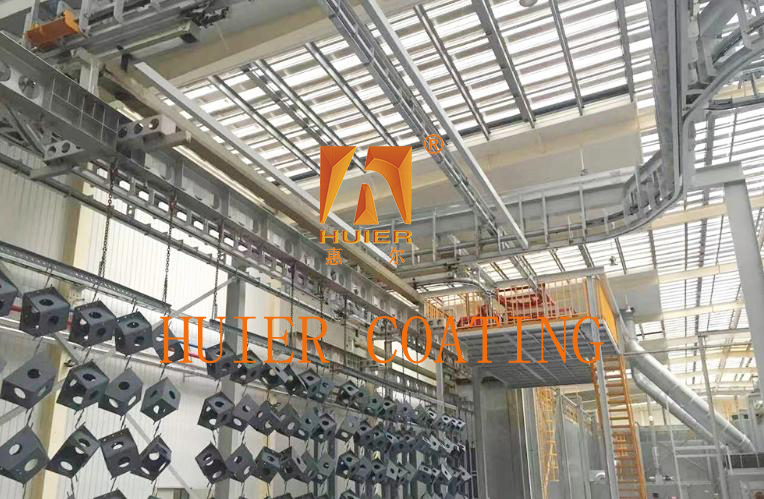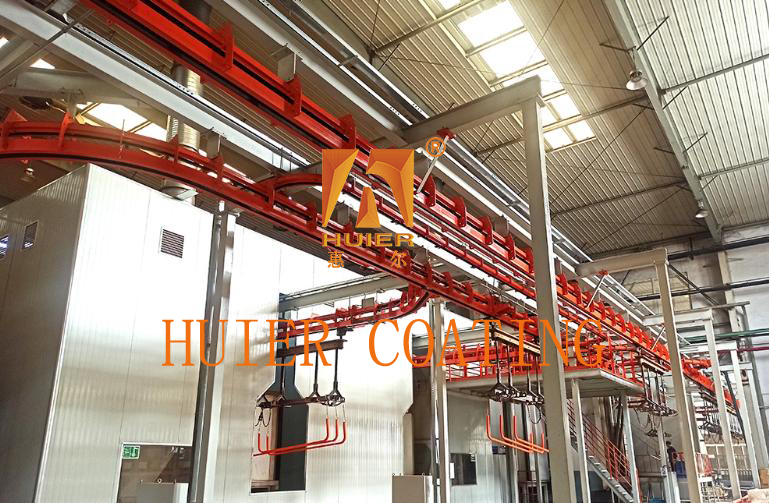| Sign In | Join Free | My ecer.jp |
|
| Sign In | Join Free | My ecer.jp |
|
| Categories | Hanging Conveyor System |
|---|---|
| Brand Name: | huier |
| Place of Origin: | zhejiang |
| Chain Type: | Double Pitch Roller Chain |
| Length: | Customizable |
| Frequency: | 50/60Hz |
| Width: | Customizable |
| Material: | Steel |
| Track Turning Radius: | Generally Between 1 - 5 Meters |
| Hanging Load: | 50kg/m |
| Control System: | PLC |
| Power Supply: | Electric |
| Hanging Rail Type: | T-Shaped Rail |
| Height: | Customizable |
| Chain Material: | Carbon Steel |
| Type: | Overhead Conveyor |
| Company Info. |
| Zhejiang Huier Coating Environmental Protection Equipment Co., Ltd |
| Verified Supplier |
| View Contact Details |
| Product List |
The accumulation and release conveyor chain is very suitable for various production, assembly and conveyor lines where the production process between each station on the entire production line needs to be coordinated with each other due to its reliable load control ability. The accumulation and release conveyor chain can stop or run the load separately without interfering with each other when the entire production line is running normally. The conveyed load can be stored online, and longer loads can be stored obliquely in dense storage areas to save space. In the field of spraying industry, the accumulation and release chain spraying line has become the choice of many companies' intelligent factories and is widely used in production lines in light industry, automobiles, motorcycles, home appliances, food and other industries. The accumulation and release equipment is equipped with electronic control technology to form a comprehensive space storage and transportation system with a high degree of automation. It is a flexible equipment with multiple functions such as lifting, transportation, and scientific management. 1. The accumulation and release chain conveyor has a large carrying capacity for workpieces. Each group of trolleys can carry a workpiece weight of 500-3000KG, which can greatly reduce the workload of manual loading and unloading and manual sand replenishment. 2. Through intelligent design, it can organize and manage complex production processes, so that workpieces can be accumulated in an orderly manner, started and stopped at any time, and cycled in time. 3. It can adjust the turnout and add links, expand or transform the conveying system, and improve its operating efficiency. 4. It has fast running speed, larger storage space, and small chain tension, which can improve production efficiency. 5. It can realize the storage of materials between workstations or processes, so that there is a certain degree of flexibility between processes, which can solve the imbalance between production processes and improve work quality. 6. It has the characteristics of low power consumption, low noise, easy to use, and low maintenance costs. 7. It saves space and energy. There is no need to hang it empty when changing colors, and there is no waste of changing lines.
The accumulation and release train set generally consists of a front trolley, a rear trolley and a load beam. A front shovel is installed on the front trolley and connected to the lifting claw through a connecting mechanism, and a tail shovel is installed on the rear trolley. When the accumulation and release operation is required, the pneumatic stopper is opened, and the lifting claw on the front trolley of the No. 1 train set is pressed down to disengage it from the pusher head on the traction chain, and the No. 1 train set stops running. The No. 2 train set continues to move forward until the front shovel of the front trolley rises along the inclined surface of the tail shovel of the rear trolley of the No. 1 train set, driving the lifting claw down and disengaging it from the traction chain, and the No. 2 train set stops running, and the same applies to the subsequent train sets. When the accumulation and release operation is completed, the pneumatic stopper is closed, and the lifting claw on the front trolley of the No. 1 train set is lifted by the weight of the front shovel itself, and the pusher head on the traction chain is in place to push the No. 1 train set forward. As the No. 1 train set moves forward, the front shovel of the front trolley of the No. 2 train set is disengaged from the tail shovel of the rear trolley of the No. 1 train set, and the lifting claw is lifted to complete the accumulation and release operation.
The accumulation type hanging conveyor realizes the conveying of workpieces on the sling by the engagement and disengagement of the trolley group and the conveyor chain pusher. It mainly consists of the following parts: conveyor track, traction chain, accumulation trolley group, drive device, tensioning device, stopper, roller group rotation device, turnout, backstop, air path control device, etc. 1. Conveyor track The track consists of two layers, the upper layer is the traction rail, which transmits traction power; the lower layer is the bearing rail, and the trolley is pushed by the pusher on the traction chain to run on the bearing rail. The workpiece is suspended on the trolley through a special sling. 2. Traction chain The traction chain is the main part of the transmission mechanism of the chain conveyor. It is composed of precision die forging outer chain pieces, inner chain pieces, pin shafts, push rod outer chain pieces, and chain support trolleys. These parts are made of high-quality alloy structural steel and have been heat treated and flaw detected, so they have good comprehensive mechanical properties and high reliability. 3. Accumulation trolley group In the suspended conveyor system, the load beam is under the traction rail, the accumulation trolley group runs along the conveying line, the load beam is connected to the cargo trolley running in the load rail, the front trolley of the accumulation trolley group has the function of engaging or disengaging with the traction chain, and the front trolley runs in the system driven by the pusher head on the traction chain. 4. Driving device The driving device is a device that provides power to the traction chain. It consists of a motor, a reducer, a frame, and a driving chain. The motor is connected to the reducer through a belt, and the crawler drive device consists of a driving sprocket, a passive sprocket and a driving chain; the driving sprocket is connected to the main shaft of the reducer, and the passive sprocket is a tensioning sprocket. The power is transmitted to the traction chain through two sprockets and the driving chain. The driving device has dual protection of mechanical overload and current overheating relays. 5. Tensioning device The tensioning device is a device that absorbs the slack generated when the traction chain is wound out of the transmission device (such as due to chain wear and temperature changes) and keeps it at a certain tension. The tensioning device is always arranged at the winding end of the drive device and close to the drive device. 6. Stopper The stopper is installed on the side of the load-bearing track and is set at the position where the accumulation trolley group needs to be stopped in the conveying system. It is a device that controls the stopping and running of the cargo trolley in the conveyor system. It is the core of the traffic control in the entire conveyor system and plays two important roles in traffic control: one is to implement safe and reliable interlocking control of the traffic to ensure the smooth passage of the trolleys in the turnout area; the other is that the stopper regulates the traffic in the conveyor line. When the traffic passes through the horizontal turning section, uphill and downhill and the operating station, the stopper releases the trolley at equal distances, which plays a role in stabilizing and balancing the traffic. 7. Roller group slewing device The roller group slewing device is a component that guides the horizontal turning of the traction chain and provides a smooth transition for it. Its structure is that a series of rollers are evenly distributed on the bracket, and the rollers are equipped with bearings. The slewing bracket is parallel to the traction track, and the number of rollers installed on the bracket depends on the radius of the horizontal curved track. The traction chain runs along the outer surface of the roller and drives the roller to rotate. 8. Switch The switch is a device that controls the running route of the cargo trolley in the accumulation conveyor system. The switch is set at the position where the running route is changed at the junction of the tracks to control the flow direction of the accumulation trolley in the conveyor system. 9. Stop The stop is a device used to prevent the first accumulation trolley entering the stop from retreating and wandering. The stop is fixed on the load-bearing track and consists of a stop plate and a bracket. When the cargo trolley runs forward, the accumulation trolley pushes the stop plate under the push of the chain, and the stop plate rotates around the axis. After the accumulation trolley passes, the stop plate rotates back to the original position under the action of its own weight. 10. Conveyor air circuit control device The air circuit unit is a device that controls the action of the cylinder. It is composed of pneumatic components such as a water separator, a pressure regulating valve, an oil mist collector, and a solenoid valve, and is assembled on a mounting plate. At the air inlet end of the air circuit unit, a stop valve is also provided to facilitate the maintenance of the air circuit unit and the cylinder. The air inlet end of the air circuit unit is connected to the compressed air pipeline with a hose, and the two outlets are connected to the cylinder interfaces respectively with hoses.



|